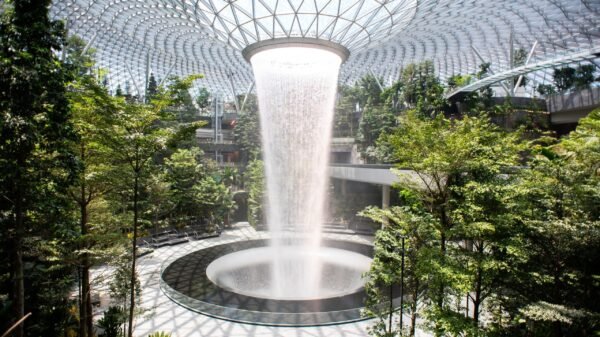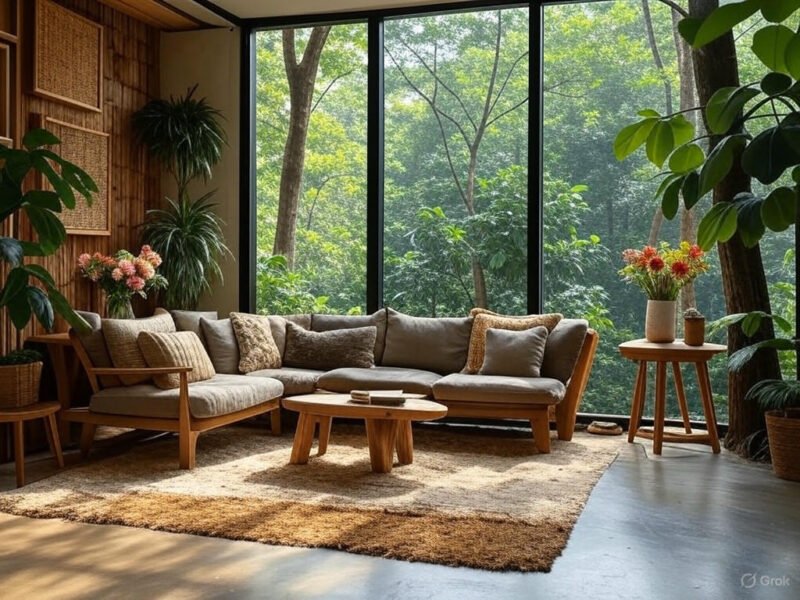As cities grow denser and urban life becomes more disconnected from the natural world, architects are turning to innovative solutions to bridge this gap. Enter biophilic design, a transformative approach that integrates nature into the built environment to enhance human well-being, sustainability, and aesthetic appeal. In 2025, biophilic design is not just a trend—it’s a movement reshaping how we conceive spaces, from homes to offices to public plazas. For architecture students, understanding biophilic design is essential to creating buildings that respond to modern challenges like mental health, climate change, and urbanization. This article explores the principles of biophilic design, its evidence-based benefits, and why it’s a cornerstone of contemporary architecture. By the end, you’ll be inspired to observe and incorporate biophilic elements in your own projects.
What is Biophilic Design?
Biophilic design draws from the concept of biophilia, a term popularized by biologist E.O. Wilson, which describes humanity’s innate affinity for nature. In architecture, biophilic design translates this affinity into intentional strategies that bring natural elements into buildings and urban spaces. It’s not just about adding a few potted plants; it’s about creating environments that mimic natural systems, engage the senses, and foster a deep connection to the outdoors.

Unlike traditional architecture, which often prioritizes functionality and aesthetics over human experience, biophilic design places well-being at its core. It uses elements like natural light, greenery, water features, and organic materials to create spaces that feel alive and restorative. From towering green skyscrapers like Milan’s Bosco Verticale to cozy homes with expansive windows, biophilic design is versatile, applicable to projects of any scale or budget.
In 2025, biophilic design is gaining momentum due to its alignment with global priorities: sustainability, mental health awareness, and resilient urban planning. As architecture students, you’re at the forefront of this shift, equipped to shape a future where buildings don’t just shelter us—they nurture us.
The Principles of Biophilic Design
Biophilic design is grounded in a framework of principles, most notably the 14 patterns outlined by environmental psychologist Stephen Kellert and colleagues. These patterns provide a roadmap for architects to integrate nature meaningfully. Below, we explore the key categories and examples of how they manifest in architecture.
1. Direct Experience of Nature
This category emphasizes tangible connections to natural elements. It includes:
-
Visual Connection with Nature: Designing spaces with views of greenery, such as gardens or forests. For example, large windows in a home overlooking a park create a calming effect.
-
Non-Visual Connection with Nature: Incorporating sounds, smells, or textures, like the sound of a water fountain or the scent of cedarwood.
-
Presence of Water: Using water features, such as indoor streams or reflecting pools, to evoke tranquility.
-
Dynamic and Diffuse Light: Mimicking natural light patterns, like skylights that shift with the sun’s movement.
A project like the Jewel Changi Airport in Singapore exemplifies this, with its indoor rainforest and cascading waterfall, immersing visitors in nature within a bustling urban hub.

2. Indirect Experience of Nature
These patterns evoke nature through representation or imitation, making them accessible even in dense urban settings:
-
Natural Materials: Using wood, stone, or bamboo to bring organic textures into spaces. A reclaimed timber accent wall can evoke a forest’s warmth.
-
Natural Patterns and Forms: Incorporating biomorphic shapes, like curved walls inspired by seashells, or fractal patterns resembling tree branches.
-
Images of Nature: Displaying artwork or murals of landscapes to stimulate a connection to the outdoors.
The Shor House in Canada, with its organic forms and natural material palette, demonstrates how indirect elements can create a serene, nature-inspired retreat.
3. Experience of Space and Place
This category focuses on spatial qualities that resonate with human instincts:
-
Prospect and Refuge: Balancing open, expansive spaces (prospect) with cozy, sheltered areas (refuge). A rooftop terrace with a shaded nook offers both.
-
Organized Complexity: Designing spaces with rich, varied details that mimic nature’s ordered chaos, like a façade with intricate, leaf-like perforations.
-
Integration of Parts to Whole: Ensuring elements work harmoniously, such as a green roof that complements a building’s overall ecosystem.
Grace Farms in Connecticut uses these principles, blending open meadows with intimate pavilions to create a community space that feels both expansive and protective.
These principles are not rigid rules but flexible tools. As students, you can experiment with them in studio projects, adapting them to different contexts, whether designing a rural retreat or an urban high-rise.
The Benefits of Biophilic Design: Evidence and Impact
Biophilic design isn’t just aesthetically pleasing; it’s backed by science. Research demonstrates its profound effects on physical health, mental well-being, and environmental sustainability. Here’s a closer look at its benefits, supported by studies and real-world outcomes.
1. Enhanced Mental Health and Productivity
Exposure to nature reduces stress and boosts cognitive function. A 2019 study published in Scientific Reports found that spending just 20 minutes in a natural environment lowered cortisol levels, a key stress hormone. Biophilic design brings this benefit indoors. For example:
-
Workplaces: Offices with biophilic elements, like Amazon’s Spheres in Seattle, report higher employee satisfaction and creativity. The Spheres’ indoor forest provides a calming space for brainstorming.
-
Schools: Classrooms with natural light and plants improve student focus and academic performance, as shown in a 2015 study by the University of Illinois.
For architecture students, this underscores the power of design to shape human experience, encouraging you to prioritize well-being in your work.
2. Physical Health Benefits
Biophilic design promotes healthier environments. Natural ventilation and non-toxic materials reduce indoor air pollutants, while access to daylight regulates circadian rhythms, improving sleep quality. Hospitals like Khoo Teck Puat in Singapore, with its green courtyards, have reported faster patient recovery times due to biophilic interventions.
3. Sustainability and Climate Resilience
Biophilic design aligns with 2025’s push for sustainable architecture. Green roofs, living walls, and passive cooling systems reduce energy consumption and carbon footprints. For instance, the Bosco Verticale towers in Milan absorb CO2 and filter pollutants, contributing to cleaner urban air. By using local, renewable materials, biophilic projects also minimize environmental impact.
4. Community and Social Connection
Biophilic spaces foster social interaction. Public parks, green plazas, and community centers with natural elements encourage gatherings and strengthen community bonds. Projects like New York’s High Line, a repurposed railway turned urban park, show how biophilic design can transform cities into vibrant, connected hubs.
These benefits make biophilic design a compelling choice for architects aiming to address modern challenges holistically. As students, you can draw inspiration from these outcomes to advocate for nature-inspired solutions in your designs.
Why Biophilic Design Matters in 2025?
In 2025, biophilic design is more relevant than ever, driven by three converging trends:
-
Urbanization: With over 60% of the global population living in cities, according to UN projections, urban dwellers crave connection to nature. Biophilic design offers a solution, bringing greenery into concrete jungles.
-
Mental Health Awareness: Post-pandemic, there’s heightened focus on mental well-being. Biophilic design’s ability to reduce anxiety and enhance mood aligns with this priority.
-
Climate Crisis: As sustainability becomes non-negotiable, biophilic design’s eco-friendly strategies—such as energy-efficient systems and regenerative materials—make it a leader in climate-conscious architecture.
These trends position biophilic design as a cornerstone of modern architecture. For students, this is an opportunity to engage with a topic that’s both cutting-edge and socially impactful. Whether you’re designing a small pavilion or a skyscraper, biophilic principles can elevate your work, making it resonate with users and the planet.
Getting Started: Biophilic Design for Students
As an architecture student, you don’t need a big budget or a real-world project to explore biophilic design. Here are practical ways to begin:
-
Observe Your Surroundings: Visit local buildings and note biophilic elements. Do you see natural light, plants, or organic materials? How do they affect the space’s mood?
-
Experiment in Studio: Incorporate one or two biophilic patterns into your next project. Try designing a classroom with a green wall or a café with dynamic lighting.
-
Sketch and Reflect: Draw a space inspired by nature—a treehouse, a riverside pavilion, or an urban rooftop. Consider how it makes users feel.
-
Research Case Studies: Study projects like the ones mentioned here (Bosco Verticale, Jewel Changi, Grace Farms) to understand how architects balance aesthetics, function, and nature.

To spark your creativity, try this challenge: Take a walk in a nearby park or green space. Observe the textures, sounds, and light patterns. Then, sketch a small structure—a bus stop, a study nook, or a pop-up café—that captures those qualities. Share your ideas in the comments below or on our forum!
Conclusion: A Call to Action
Biophilic design is more than a trend—it’s a philosophy that redefines architecture’s role in human and environmental health. By weaving nature into our buildings, we create spaces that heal, inspire, and sustain. For architecture students, this is an exciting time to embrace biophilic design, experimenting with its principles to shape a better future.
At www.architecture-student.com, we’re kicking off a series on biophilic design to dive deeper into its applications, case studies, and future potential. Stay tuned for our next article, where we’ll explore how architects are bringing nature indoors with innovative techniques. In the meantime, start noticing biophilic elements around you. How can you bring a piece of nature into your next project?

2 thoughts on “Understanding Biophilic Design: Principles and Benefits”